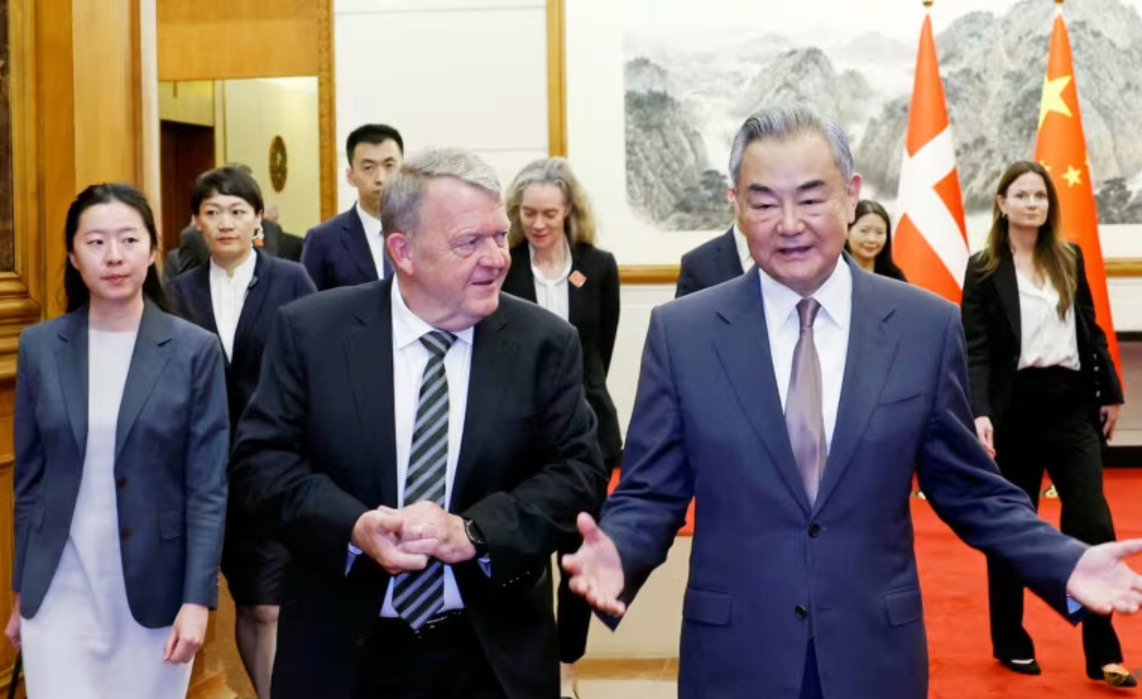By drawing a parallel between U.S. interest in Greenland and its stance on Taiwan, China has mounted a carefully calibrated rhetorical response that highlights perceived inconsistencies in American positions on sovereignty, positions itself as a defender of international norms, and gently tests the cohesion of Western alliances.

Chinese Foreign Minister Wang Yi meets Denmark's Foreign Minister Lars Lokke Rasmussen in Beijing, China, on May 19, 2025. China fully respects Denmark's sovereignty and territorial integrity on the Greenland issue and also hopes Denmark to continue to support China's legitimate position on issues concerning China's sovereignty and territorial integrity, says Wang.
When Foreign Minister Wang Yi declared that China “fully respects Denmark’s sovereignty on the Greenland issue and hopes that Denmark will continue to support China’s legitimate position on issues related to its own sovereignty and territorial integrity,” he engineered a geopolitical checkmate: if Washington can entertain the idea of procuring unilaterally foreign territory, why can’t Beijing frame Taiwan’s status as a matter of domestic reconfiguration?
Beijing weaponized the analogy. By reframing Trump’s revived interest in acquiring Greenland as a sovereignty litmus test, the People’s Republic of China has drawn a deliberate parallel that subtly challenges the United States’ position on Taiwan. This calculated rhetorical counteroffensive carries global ramifications.
Its force lies not in escalation, but in reversal. China’s message—your Greenland is our Taiwan—exposes U.S. contradictions. Instead of antagonizing the West head-on, Beijing appropriates the language of the liberal order, affirming small-state authority while sidestepping open confrontation with great-power adventurism.
This inversion is deliberate. By linking Greenland and Taiwan—two unrelated sovereignty claims—China exposes the fault lines of U.S. territorial doctrine. From Nuuk to Taipei, it reframes sovereignty on its own terms, not by antagonizing American power but by eroding the credibility of the positions that underpin it. In doing so, Beijing places itself as the only superpower defending territorial integrity and the international order.
Ambush by Principle
Timing was essential. By waiting several months after Trump’s reignited interest in Greenland, and seizing the occasion of the Danish Foreign Minister’s visit, following Copenhagen’s hosting of former Taiwan President Tsai Ing-wen, China ensured its response appeared measured rather than reactive. The result is a rhetorical ambush that undermines U.S. logic without firing a shot.
By channelling the message through Denmark, China avoids direct provocation and appeals to smaller states wary of great-power interference. It rejects the revisionist label and adopts the posture of a principled actor, forcing the U.S. to confront a binary it usually avoids: either sovereignty is sacrosanct, or it is selectively enforced—the American exceptionalism. If the latter holds, Beijing asks: why should China be denied the same flexibility?
In doing so, China tests Europe’s resolve as well. The Greenland–Taiwan analogy now places pressure on Western cohesion, especially in Brussels, where today’s alignment with Washington risks compromising the very norms the EU claims to uphold. This tension is amplified in Copenhagen, where U.S. pressure has disrupted long-standing diplomatic habits.

U.S. President Donald Trump talks of the importance of Greenland and Panama to U.S. security at the same time that Donald Trump Jr is visiting Greenland in early January 2025.
The Danish Quandary
Indeed, Trump’s renewed interest in Greenland has placed Denmark in an uncomfortable position. For decades, the Danish foreign policy mantra has focused on tight alignment with Washington. The current Prime Minister, a known China hawk, previously led EU criticism of Beijing. Yet Trump has overturned this stance, pushing Denmark away from the U.S. and closer to the EU core. Nuuk, for its part, moved in the opposite direction: Greenland’s Foreign Minister, Vivian Motzfeldt, is currently working to deepen ties with China.
Beijing quickly seized the opportunity. Marking the 75th anniversary of diplomatic ties with Denmark, the Danish Chamber of Commerce in Beijing wrote directly to President Xi Jinping. Most unusually, Xi replied personally—what the recipient described as a “happy surprise”—a visible sign of the value China now places on this evolving relationship with Denmark.
Nevertheless, beneath the diplomacy lies strategic intent. China seeks economic and infrastructural inroads in Greenland that would secure access to the Arctic, a region of growing geopolitical weight. If that materializes, the U.S. would face the possibility that a deepening China-Denmark-Greenland relationship could yield dual-use infrastructure—installations that, in the event of a crisis, could support Chinese naval operations and directly challenge American presence in the region.
This isn’t speculation. Research from the University of Copenhagen confirms that Greenland’s leadership increasingly sees China as a vital partner. Indeed, Nuuk opened a Representation Office in Beijing in November 2021. Chinese investment is not viewed as a geopolitical threat, but a route toward economic diversification—and potentially, in the long term, independence from Denmark. As Chuan Chen notes, sectors like mining, fishing, and tourism are key to this aspiration, and China remains one of the few actors both willing and able to invest at scale.
The stakes, therefore, extend beyond territory to control over Arctic infrastructure and sea routes, access to natural resources, and influence in emerging governance frameworks. At that level, the real contest concerns the meaning of legitimate power: is sovereignty a fixed norm or a flexible tool?
Washington’s answer will define the next phase. If it embraces transactional territorialism, it weakens its strategic ambiguity on Taiwan by conceding that sovereignty is negotiable. If Trump aims to create a North American sphere of economic and security control stretching from Panama in the South to Greenland in the North, then it becomes harder to deny China a parallel claim with respect to Taiwan, and the South China Sea.
Strategic Implications
The implications are fourfold—and none align with what Trump likely envisioned when he proposed the Greenland take over.
First, Beijing exposes Washington’s selective invocation of sovereignty. It does not seek recognition; it forces contradiction. By aligning itself with the principle of sovereign equality while the U.S. treats it as conditional, China forces Washington into a defensive posture, compelled to justify why territorial integrity applies rigidly in Ukraine, Taiwan or the South China Sea, but flexibly in Greenland, Panama or wherever Trump’s next impulse lands.
Second, it strains NATO unity by forcing European members—especially Denmark—to choose: uphold alliance loyalty or assert sovereign autonomy. As U.S. positions appear transactional, Europe faces a credibility test. The very norms that underpin NATO begin to fray when they are seen as contingent on U.S. interests, weakening the alliance’s coherence.
Third, China revives and repurposes what we previously identified in this same outlet as the “Trump Corollary”—a logic shaped by protectionism, isolationism, and nationalism. Beijing uses this equivalent rationale not to reject U.S. standards outright but to question their universality. In other words, by mirroring American language on sovereignty and interest, China recasts itself not as an outlier but as an equal participant operating by the rules the U.S. itself has normalized.
Fourth, this strategy allows Beijing to blur the line between revisionism and status quo defense. By occupying the space traditionally claimed by the U.S.—invoking dominance, order, and self-determination—China presents itself as both a unilateral challenger of Washington and a collective guardian of international rules. This dual role makes resistance more complex: opposing Beijing’s claims risks exposing inconsistencies in the very principles Washington seeks to uphold.
Redrawing the Map through Analogy
In this confrontation, China demonstrates that exposing duplicity can be more destabilizing than open defiance. For American policymakers, the task is not just to refute China’s analogies, but to face the deeper structural ambiguity in their own positions. In a world increasingly attuned to double standards, the moral clarity that once underpinned U.S. leadership is now open to challenge.
Washington faces, therefore, a dilemma: either universalizes its commitments or accepts their elasticity. Either way, the debate is set beyond American terms. China has redrawn the conceptual map—less through opposition than through analogy, and with consequences that extend far beyond the Arctic.
